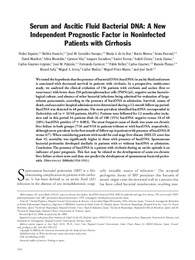Título :
Serum and ascitic fluid bacterial DNA: a new independent prognostic factor in noninfected patients with cirrhosis |
Autor :
Zapater, Pedro 
Francés, Rubén 
González Navajas, José Manuel
de la Hoz, María A.
Moreu, Rocío
Pascual, Sonia 
Monfort, David
Montoliu, Silvia
Vila, Carmen
Escudero, Amparo
Torras, Xavier 
Cirera, Isabel 
Llanos, Lucía
Guarner-Argente, Carlos 
Palazón, José M.  |
Editor :
Wiley |
Departamento:
Departamentos de la UMH::Medicina Clínica
Departamentos de la UMH::Farmacología, Pediatría y Química Orgánica |
Fecha de publicación:
2008 |
URI :
https://hdl.handle.net/11000/35360 |
Resumen :
We tested the hypothesis that the presence of bacterial DNA (bactDNA) in ascitic fluid and serum is associated with decreased survival in patients with cirrhosis. In a prospective, multicenter study, we analyzed the clinical evolution of 156 patients with cirrhosis and ascites (first or recurrence) with lower than 250 polymorphonuclear cells (PMN)/muL, negative ascites bacteriological culture, and absence of other bacterial infections being admitted for evaluation of large-volume paracentesis, according to the presence of bactDNA at admission. Survival, causes of death, and successive hospital admissions were determined during a 12-month follow-up period. BactDNA was detected in 48 patients. The most prevalent identified bactDNA corresponded to Escherichia coli (n = 32/48 patients, 66.6%). Patients were followed for 12 months after inclusion and in this period 34 patients died: 16 of 108 (15%) bactDNA negative versus 18 of 48 (38%) bactDNA positive (P = 0.003). The most frequent cause of death was acute-on-chronic liver failure in both groups (7/16 and 9/18 in patients without or with bactDNA, respectively), although more prevalent in the first month of follow-up in patients with presence of bactDNA (0 versus 4/7). When considering patients with model for end-stage liver disease (MELD) score less than 15, mortality was significantly higher in those with presence of bactDNA. Spontaneous bacterial peritonitis developed similarly in patients with or without bactDNA at admission.
Conclusion: The presence of bactDNA in a patient with cirrhosis during an ascitic episode is an indicator of poor prognosis. This fact may be related to the development of acute-on-chronic liver failure at short term and does not predict the development of spontaneous bacterial peritonitis.
|
Tipo de documento :
info:eu-repo/semantics/article |
Derechos de acceso:
info:eu-repo/semantics/openAccess
Attribution-NonCommercial-NoDerivatives 4.0 Internacional |
DOI :
10.1002/hep.22564 |
Publicado en:
Hepatology. 2008 Dec;48(6):1924-31 |
Aparece en las colecciones:
Artículos - Farmacología, Pediatría y Química Orgánica
|

 La licencia se describe como: Atribución-NonComercial-NoDerivada 4.0 Internacional.
La licencia se describe como: Atribución-NonComercial-NoDerivada 4.0 Internacional.
.png)